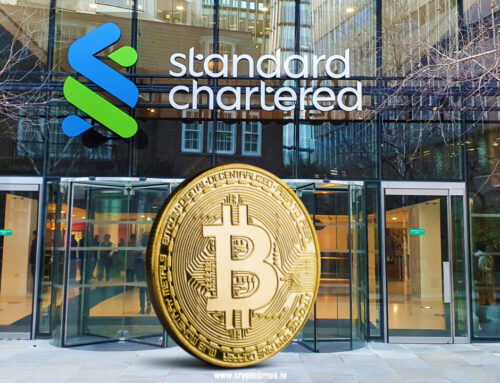Investing during uncertainty. How to act in a volatile world?
April 1, 2025
We live in an era of turbulence in financial markets—pandemics, military conflicts, political uncertainty, the looming U.S. debt crisis, and rapidly shifting global economic policies are all pushing investors to seek ways to protect their capital while still aiming for returns—even under challenging conditions.
It’s fair to say that during times of uncertainty, the number of possible scenarios increases. To paraphrase an old saying: “More things can happen than will happen.” The range of potential outcomes is wide, but only one of them will ultimately occur. What’s more, even the most probable scenario is never guaranteed.
Start investing today or test a free demo
Open real account
TRY DEMO
Download mobile app
Download mobile app
Naturally, investors are still trying to find assets that can generate profits. Capital is always on the move, looking for returns—regardless of the “weather” in the economy or geopolitics. So, which strategies and asset classes may prove effective in uncertain times? What are global investors focusing on? What are the outlooks for key asset classes—and what should we expect going forward?
Gold – A safe haven in turbulent times
Gold has been regarded as a symbol of stability for centuries—and recent years have only reinforced that reputation. While gold has traditionally been seen as a safe haven, its increasing correlation with stock markets in certain periods caused some investors to shy away. This was particularly evident in 2022, when gold traded sideways amid rising global interest rates. Despite its reputation for protecting against inflation, it was precisely during a period of multi-decade-high inflation that many investors took profits off the table.
Since then, the situation has changed significantly. Investors returned to gold, driven by geopolitical concerns, fears of trade wars, and growing economic uncertainty. On the COMEX exchange, record volumes of physical gold deliveries to U.S. vaults emptied stockpiles in London and Switzerland. For a time, investors had to wait months for delivery fulfillment. The physical market remains tight, which could amplify price reactions if the rally continues.
Since the escalation of the Middle East conflict—and with the war in Ukraine still ongoing—gold prices have surged, reacting to growing global instability. In March 2025, the metal reached an all-time high, nearing $3,100 per ounce, further fueled by speculation around Donald Trump’s economic policies—especially the potential for new tariffs that could shake global trade. Add to that the U.S. debt crisis, which challenges the notion of global financial stability. There are even discussions about the potential revaluation of gold as a U.S. reserve asset, which could trigger further demand from central banks. Over the past three years, central banks have purchased more than 1,000 tons of gold annually. 2025 is likely to follow that trend.
So why gold?
In times when traditional financial markets lose predictability, gold is treated as a hedge against rising inflation and currency devaluation. It may not generate interest or dividends, but it tends to gain value in times of chaos, making it an attractive asset for those looking to diversify. And it’s important to remember: the world’s gold supply is limited. While gold production grows by about 2% annually, that’s far less than the growth in global money supply. Additionally, in the face of recession and stagflation headlines, many investors simply feel uncertain about putting their wealth into higher-risk assets like equities or cryptocurrencies. As a result, gold often becomes the first store-of-value choice, and ETFs make access to it easier than ever before.
Gold is gaining primarily in response to uncertainty surrounding Donald Trump’s trade policy. Historically, during numerous geopolitical events over the past several decades, gold has tended to rise in value over the medium and long term.
Source: Bloomberg Finance LP, XTB
Stocks – A flight to defensive assets
The stock market—particularly in the United States—remained overheated following the emergence of the artificial intelligence (AI) investment boom. Shares of the world’s largest tech companies surged on investor optimism over future growth and the potential for even higher profits.
Eventually, however, the reality check came: corporate earnings failed to meet high expectations. Now, a clear trend has emerged in equity markets—a capital shift toward so-called defensive stocks.
Defensive stocks belong to companies whose financial results are less sensitive to economic cycles. These typically include sectors such as:
- Utilities (energy and infrastructure)
- Healthcare
- Consumer staples (basic goods and services)
European defense stocks in the spotlight
In Europe, special attention is being given to defense-related companies. The potential for increased defense spending within the European Union—driven by rising geopolitical tensions—has turned this sector into a magnet for investors.
The EU may channel up to €800 billion into defense initiatives, with:
- €650 billion expected to come directly from member states (including a proposal to exclude military spending from debt limits), and
- An additional €150 billion potentially funded through joint debt issuance.
Germany—historically hesitant about taking on new debt—is now easing fiscal constraints. The country plans to invest €500 billion in infrastructure, and with its defense spending target approaching 3% of GDP, total expenditures could reach €1 trillion in the coming years.
Crucially, this investment drive could proceed regardless of a slowdown in European consumer demand, reflecting a fundamental shift in budget priorities.
Defensive stocks: Modest in booms, resilient in storms
While defensive stocks rarely offer spectacular returns during bull markets, their stability becomes a key advantage in uncertain times. European markets, in particular, may benefit if defense investment plans accelerate further. In the months ahead, investors will be assessing which companies may be most affected by rising tariffs. One thing is certain: many firms will face increased costs, and not all will be able to offset them with higher sales—especially if consumers push back against steeper prices.
Source: Bloomberg Finance L.P., XTB
Since the outbreak of the war in Ukraine, shares of European defense companies have performed exceptionally well — and following Donald Trump’s victory, that trend has accelerated. Meanwhile, the U.S. defense sector has underperformed. Why? The market is betting that Europe will increase defense spending regardless of the global landscape, driven by rising NATO budgets and geopolitical risks — especially if the U.S. signals a possible withdrawal from the continent.
At the same time, the resurgence of American isolationism and a renewed focus on fiscal discipline casts doubt on whether the U.S. will continue to heavily subsidize its defense contractors. It also raises questions about whether all categories of weapons — including those perceived as costly or outdated in the context of modern warfare — will continue to receive production support.
Bonds – A bastion of capital preservation
Bonds—or ETFs providing indirect exposure to them—remain a core component of any well-balanced investment portfolio, especially in times of market stability. They offer a regular, predictable stream of income through interest payments, which enables better financial planning.
Bonds help stabilize portfolios by diversifying risk. They often move inversely to equities, helping to reduce overall volatility and sensitivity to market swings.
Interest rates play a crucial role in bond pricing, with an inverse relationship: when rates rise, bond prices fall, and when rates drop, bond prices rise. In a stable environment, this dynamic is more predictable, making risk management easier.
Longer maturities mean greater sensitivity to rate changes—and higher risk for the bondholder. Choosing the right maturity helps balance risk and return. Investors can fine-tune their portfolios using strategies like:
- Laddering (buying bonds with staggered maturities)
- Immunization (matching bond portfolio duration to the investment horizon)
In periods of stability, high-quality bonds offer a strong foundation, preserving capital and generating inflation-buffered returns.
Forex – Currencies as a defensive shield
The foreign exchange (forex) market is often where uncertainty surfaces first. During crises or times of elevated global tension, investors tend to move toward so-called “safe haven” currencies, such as the U.S. dollar (USD), Japanese yen (JPY), or Swiss franc (CHF).
The USD remains the world’s dominant reserve currency, though its status could come under pressure if a Republican administration enacts aggressive protectionist trade policies.
The JPY, long associated with slow growth, is regaining its safe-haven appeal. Recent GDP growth despite weak consumption, rising wages, and the Bank of Japan’s signal to resume rate hikes have revived investor interest in the yen, following 2024’s turbulence.
The CHF continues to be a safe-haven currency, supported by Switzerland’s neutrality and its limited exposure to trade wars.
Currency hedging or using forward contracts can help protect investors from domestic currency devaluation. Grounding forex decisions in macroeconomic fundamentals also reduces speculative risk and favors those with a deeper understanding of:
- Business cycles
- Central bank actions
- Geopolitical shifts
Success in the forex market often hinges on analyzing government bond yields, which serve as barometers of risk appetite and interest rate expectations—both of which strongly influence currency demand.
That said, forex remains a highly dynamic and volatile market, where every macroeconomic release and central bank statement can move prices. Quick reflexes, experience, and ongoing learning are essential for navigating this fast-moving arena.
Yields on 10-Year Government Bonds in Japan and the U.S. (Top), and USD/JPY vs. Yield Spread (Bottom)
Source: xStation5
Bitcoin – A deflationary hedge?
Bitcoin continues to dominate headlines. Why? Staggering gains in 2024 and a new U.S. administration that appears to be in the early stages of supporting the entire crypto sector. It’s laying the groundwork for policies that could directly drive new demand for Bitcoin.
As the oldest cryptocurrency, Bitcoin holds a well-established position within the blockchain ecosystem and may be granted a unique status as a strategic U.S. asset. As a result, speculative interest could grow—even if price volatility remains high.
Bitcoin’s supply is capped at 21 million BTC, with more than 19.84 million already mined. Its deflationary design makes it structurally different from fiat currencies—often “debased” by central banks. For over a decade, Bitcoin has served as a store of value over time, attracting users, speculators, and long-term holders alike—many of whom view it as digital gold.
While Bitcoin often behaves like a high-risk asset, there are periods when it outperforms equities or even gold, temporarily breaking correlations with traditional markets. For this reason, Bitcoin may serve as a strategic, low-allocation asset in an “all-weather” portfolio aimed at combining growth potential with uncorrelated assets.
Historically, Bitcoin’s price has been influenced by four-year halving cycles, during which extreme volatility is common. Investors using ETPs (such as ETCs or ETNs) to gain exposure can include Bitcoin as part of a long-term diversification strategy—accepting higher short-term volatility in exchange for asymmetric upside.
Bitcoin’s growing role isn’t just speculative. It is evolving into a meaningful alternative payments system, now handling transaction volumes comparable to Mastercard and Visa. It was designed as a counterweight to fiat currency, and today, Bitcoin serves a real purpose in countries where trust in government is weak or banking systems are underdeveloped.
ETFs – Diversification in a simple format
Exchange-Traded Funds (ETFs) have become one of the most popular investment tools—especially during times of uncertainty. By providing exposure to entire indices rather than individual stocks, ETFs help reduce company-specific risk.
During uncertain times, sector-specific ETFs targeting so-called defensive sectors are particularly attractive. These include:
- Healthcare
- Energy
- Consumer staples
- Utilities
These sectors tend to be resilient during downturns, as they provide essential goods and services that consumers are least likely to cut back on.
In addition, during geopolitical tensions, defense-related ETFs gain popularity as increased military spending tends to drive sector performance.
Beyond equity-based ETFs, investors may also consider bond ETFs, both short- and long-term. Since longer-duration bonds are more sensitive to interest rate expectations, in uncertain periods, shorter-duration bond ETFs can provide more stable performance.
Moreover, ETFs can offer ready-made portfolio strategies across asset classes. For example, the Vanguard Lifestrategy 80/20 ETF allocates 80% to equities and 20% to bonds, making it easier for investors to diversify without managing each position individually.
Lastly, ETFs aren’t limited to stocks or bonds. ETCs offer exposure to gold, while ETNs allow indirect investment in Bitcoin—offering diversified access to non-traditional assets, without the storage and custody costs often associated with holding physical gold.
Futures Contracts – hedging in action
Futures contracts are one of the most widely used tools for hedging a portfolio against adverse market movements. The hedging mechanism involves taking a position opposite to the one already held in a portfolio. For example, an investor who holds a basket of S&P 500 stocks and fears a short-term downturn can open a short position in S&P 500 futures instead of selling the entire portfolio.
Futures are also favored by speculative capital due to the leverage they offer, which amplifies both potential gains and losses.
Managing volatility in uncertain times
As market predictability plummets and geopolitical tensions fuel volatility, futures are increasingly returning to the spotlight. They serve both as capital protection tools and instruments for active risk management.
Futures contracts allow investors to take positions on both rising and falling prices of nearly any asset class—equities, commodities, bonds, or currencies—without owning the underlying asset. This accessibility makes them highly versatile in uncertain environments.
The range of futures includes all major asset classes—and more. For example:
- Investors can hedge U.S. equity market volatility via the VIX index.
- In Europe, the EURO STOXX 50 Volatility Index offers a comparable hedge for European equity exposure.
- More experienced traders may even hedge against monetary policy shocks using interest rate futures, protecting portfolios from sharp moves in bond or equity valuations triggered by central bank decisions.
It’s important to note: hedging is not about generating profits—its goal is to limit potential losses.Trading futures is a demanding strategy that requires both technical knowledge and psychological resilience. Leverage enables significant returns on relatively small capital, but it also magnifies risk: small market moves can lead to outsized profits or rapid losses.
Because of this dual nature, futures attract both:
- Risk-averse investors seeking protection from market downturns, and
- Speculators pursuing high-risk, high-reward opportunities.
VIX and market fear: An inverse relationship
The VIX index, which tracks volatility in the U.S. equity market, is inversely correlated with the S&P 500 index. As shown in the chart, each upward spike in the VIX typically corresponds with a market selloff in the S&P 500.
Source: XTB Research
Conclusion: Investing in uncertain times
Investing during uncertainty is an art of balancing capital protection with return potential.
Heightened volatility can create extraordinary profit opportunities—but also amplifies the risk of losses.
- Gold shines as a safe haven,
- Defensive stocks and ETFs offer stability,
- Bonds protect capital from market drawdowns,
- Forex and futures enable active, strategic risk management.
The key to navigating volatile markets is diversification and aligning strategies with individual goals and risk tolerance. In stormy times like today, caution and flexibility are the investor’s greatest allies.
AI hype faces its first real test
While the AI investment boom is being tested, gold (yellow line) has surged by approximately 20% since the start of the year, climbing from around $2,600 in late December/early January to $3,150 per ounce today. In contrast, the US100 index (Nasdaq 100 futures) has fallen by nearly 10%, as investor sentiment toward U.S. tech stocks has deteriorated, particularly in AI-related names.
Source: xStation5
Search
RECENT PRESS RELEASES
Related Post



